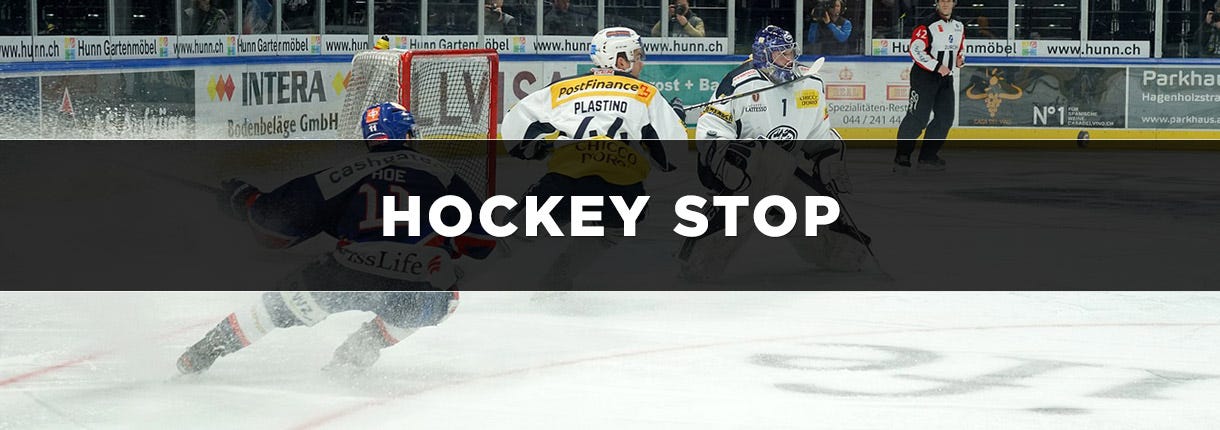A Guide to the Ice Hockey Stop

Mastering your hockey stop is fundamental for any ice hockey player looking to improve their game. This powerful stopping technique lets you change direction quickly and offers a significant advantage in speed and control on the ice.
This guide shares hockey stop tips so you know everything about performing a proper hockey stop, and there are also tips for beginners wanting to improve their technique.
With the right skill and knowhow, you can execute critical moves like a pro in no time – it just takes a little practice and determination. Read on to learn more about how to hockey stop.
In this article, we’ll cover:
What is a Hockey Stop?
The hockey stop is an essential skating maneuver that lets you quickly change direction or come to a complete stop while keeping your balance on your hockey skates. It involves simultaneously using the inside edges of your skates while digging into the surface of the ice at an angle. The friction created between the skate blade and ice slows down your momentum until you come to a complete stop.
It’s a move that requires precision-control over your body weight distribution, leg positioning, and foot pressure that’s applied on each skate blade. Mastering it improves your overall skating ability and enhances your game performance by allowing quick transitions from offense to defense.
Why Is It Called a Hockey Stop?
The term “hockey stop” comes from the widespread use in ice hockey as one of the most critical moves during gameplay. While other sports involving skating may have similar stopping techniques – like figure or speed skating – none are quite as abrupt or powerful as the hockey stop.
Advantages of the Hockey Stop
The hockey stop is an essential skill for any ice hockey player. It permits them to swiftly and effectively change directions and is seen as a must-have for the fast-paced game.
Quick direction changes
One of the main advantages of a proper hockey stop is that it allows you to make rapid direction changes on the ice. This agility can help you evade opponents or quickly reposition yourself. Switching directions without losing speed gives you an edge over competitors who may struggle with less efficient stopping techniques.
Better puck control
A well-executed hockey stop also improves puck control, as it helps with stability while maneuvering around opponents on the ice. By keeping balance and control, you’ll be better equipped to handle sudden shifts in play and keep possession of the puck.
Increase speed and agility
An effective ice hockey stop can significantly increase your overall speed and agility, especially with powerful strides and quick acceleration.
How to Stop in Hockey Skates
Now that you understand what a hockey stop is and see its importance, we can dive into the technique you’ll want to master to execute it correctly. Learning how to perform a proper hockey stop might seem intimidating, but with practice and persistence, you can master it quickly.
To learn a proper hockey stop, just follow these simple steps:
- Build up some speed: Start by skating forward at a moderate pace to give you enough momentum for your skate blades to grip the ice during the stopping motion.
- Bend your knees: As you begin the stop, bend your knees slightly while maintaining an upright posture to lower your center of gravity and improve stability throughout the maneuver.
- Pivot on the front foot: Rotate your front foot so it’s perpendicular to your direction of travel (approximately 90 degrees). The inside edge of this skate should now be facing forward while you apply pressure on it. Remember not to lean too far back or forward so you can keep your balance.
- Dig in with both skates: While keeping pressure on the inside edge of your front skate, start turning your back foot so the outside edge also digs into the ice. Both feet should form an angle, similar to an inverted “V.”
- Maintain balance and control: Throughout the entire process, maintain balance and control by keeping your knees bent, chest up, and head looking forward. This helps you stay centered over your skates as they slide across the ice.
- Practice makes perfect: Like any skill in ice hockey, mastering the hockey stop takes time and practice – progress gradually as you get more accustomed to the movement, and can increase your speed incrementally.
What Are the Different Types of Hockey Stops?
In addition to the traditional hockey stop, there are several other ways to stop yourself while skating. Each type of stop has unique techniques and advantages depending on your skill level and situation during a game.
Let’s explore some of these alternative stopping methods:
- Snowplow Stop: This is often the first stopping method taught to beginners, as it’s relatively easy to learn. To perform a snowplow stop, angle both skate blades slightly inward and apply pressure on the inside edges while bending your knees.
- Two-Foot, Inside/Outside Edge Stop: Also known as a parallel stop or T-stop, this method uses both feet, with one foot applying pressure on the inside edge and the other applying pressure on the outside edge. This creates more friction against the ice surface for an effective halt.
- Two-Foot, Inside Edge Stop: Similar to the previous method, but with both feet simultaneously applying pressure on the inside edges only. It requires good balance and control over your skates’ edges.
- One Foot, Inside Edge Stop: In this advanced technique, you’ll use just one foot (usually your dominant leg) by placing it perpendicular to your direction of travel while maintaining weight distribution between both legs for stability. Experienced hockey players commonly use this stop to quickly change direction or evade opponents.
Hockey Stop for Beginners – Helpful Tips
Learning how to perform a hockey stop can be challenging, especially for beginners. However, with proper guidance and practice, it’s a skill that can be mastered. Following are helpful tips designed for those just starting to learn the hockey stop.
- Stop-Start: Begin by practicing stopping and starting on both feet. Start by sliding ahead slowly and then attempt to halt with one foot before alternating to the other. Start gliding forward slowly and then try stopping using one foot before switching to the other.
- Rotate Hips: Rotating the hips is crucial when performing a hockey stop. While turning sideways into the stop position, rotate the hips toward the turn and keep the knees bent slightly outward. This rotation helps generate more power and control during stops.
- Planting Your Feet: Both skate blades must make contact with the ice simultaneously as they slide across its surface. Practice planting both feet firmly onto the ice while initiating each stop to ensure better stability.
- Start Slow: It’s essential not to rush the learning process when mastering any new skill – including hockey stops. Taking time to perfect each technique at slower speeds before gradually increasing the pace is a good approach.
Hockey Stop FAQ
Is it hard to do a hockey stop?
The difficulty of performing a hockey stop varies from skater to skater. Some players find it easier than others due to factors such as experience and comfort on skates. However, with practice and determination, anyone can learn how to execute an effective hockey stop.
How long does it take to learn to hockey stop?
How long it takes to learn a proper ice hockey stop depends on progress, skill, and dedication. For some, acquiring the hockey stop will be a quick process. It could require extended practice periods for others. The key is patience and persistence.
How can I improve my hockey stop?
- Focused Practice: Spend time on your stopping technique during each practice session.
- Mentorship: Ask for help from experienced hockey players, coaches, or instructors who can provide valuable tips and feedback.
- Analyze Your Technique: Record yourself practicing stops so you can review your form and identify areas that need improvement.
- Incorporate Drills: Add drills that focus on stopping into your practice routine.
How can I practice hockey stops at home?
If you don’t have access to an ice rink, there are still ways to work on your hockey stop skills. One option is using inline skates and practicing stops on a smooth surface, like a driveway or basketball court. Another possibility is working on your balance and leg strength with off-ice exercises that mimic the movements involved in stopping.
How do you do a two-foot stop in hockey?
A two-foot stop involves using both feet simultaneously while maintaining proper weight distribution. To execute this type of stop:
- Bend your knees and keep your body centered over your skates.
- Pivot both feet so they’re perpendicular to the direction of travel.
- Dig the inside edges of both skate blades into the ice while applying pressure evenly across each foot.
Can you hockey stop in figure skates?
It’s technically possible to perform a basic hockey-style stop in figure skates, but it may be more challenging due to differences in blade design between the two types of skates. Figure skate blades have toe picks at their front end, which could catch onto the ice during attempts at executing a traditional hockey stop.
The First Step to a Good Hockey Stop – Have the Right Skates
Before you can master the hockey stop, having the right pair of skates is essential. A hockey player’s skates are crucial to the ability to perform this – or any – skill effectively and safely.
Browse HockeyMonkey’s full selection of hockey skates today to find the perfect skates for your game.











